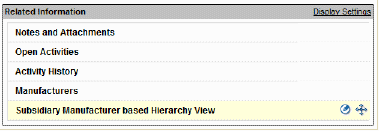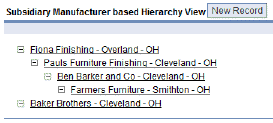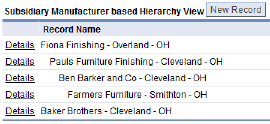Difference between revisions of "Self Reference Lookup"
imported>Aeric |
imported>Aeric |
||
| Line 29: | Line 29: | ||
#;Section:Choose a section in the form layout (default selection can be used) | #;Section:Choose a section in the form layout (default selection can be used) | ||
#Provide any other necessary information in the ''Basic Information'' and ''Display Attributes'' sections | #Provide any other necessary information in the ''Basic Information'' and ''Display Attributes'' sections | ||
#Click '''[Save]''' | #Click '''[Save]''' | ||
{{Note| | {{Note|Whenever you create a lookup to this object in another object, you'll generally want to edit the ''Display Attributes'' section, and set the ''Record Selection Type'' to '''Hierarchical'''. You may want to do that here, as well, if the data you are planning to add a deep set of data. However, you won't be able to select the Hierarchical option until the definition of the new self-referencing lookup field has been saved.}} | ||
Then: | Then: | ||
Revision as of 23:36, 9 September 2011
An Object can contain a Lookup field that references the Object itself (i.e. a self reference). This configuration is used to build record hierarchies (parent-child relationships between records) which are displayed in a Related Information section.
- Examples
-
- An organization might have multiple subsidiaries, and some of those companies might also have subsidiary companies
- Employees have reporting relationships, to managers and subordinates
- In manufacturing, parts in a component might have subcomponents (or be part of of a larger component)
- Considerations
-
- When a Self Reference Lookup field is added, a new section is added to Related Information
- The new section is named: <object> based Hierarchy View, where <object> is the Lookup Type, or object name; Learn more: About Objects in Lookup Fields
- The new section is added to all the Forms of the object
- By default, this new section is hidden
- When visible, this section displays a hierarchy view of the records
- A Self Reference Lookup field:
Add a Self Reference Lookup Field to an Object
First:
- Click Designer > Data > Objects > {object}
- Click the Fields tab, click the [New Field] button, and complete the following information:
- Label
- Label to display in the form layout
- Display Type
- Lookup
- Object Name
- Choose the {object} selected in the first step
- Field Name
- Name of the field (Parent {object} is a common choice)
- Section
- Choose a section in the form layout (default selection can be used)
- Provide any other necessary information in the Basic Information and Display Attributes sections
- Click [Save]
Note: Whenever you create a lookup to this object in another object, you'll generally want to edit the Display Attributes section, and set the Record Selection Type to Hierarchical. You may want to do that here, as well, if the data you are planning to add a deep set of data. However, you won't be able to select the Hierarchical option until the definition of the new self-referencing lookup field has been saved.
Then:
- Click the Forms tab
- Scroll to the Related Information Section
- Click the Display Settings link in the heading
- Move the object labeled: {object} based Hierarchy View to the Visible Objects area
- Click [Save]
Create a Self Reference Lookup between Records
- Navigate to the {object} tab (Company, for example)
- Edit a record, select a Parent Company from the lookup field and Save the record
- Select the record designated as Parent Company
- Scroll down to the Company based Hierarchy View section
- Note that child Companies are displayed in the tree, demonstrating the relationships between records in the Company object
Edit an Object based Hierarchy View
To edit an <object> based Hierarchy View:
- Click Designer > Data > Objects
- Navigate to the object of interest
- In the Forms tab, navigate to the Related Information section
- Navigate to the <object> based Hierarchy View, click the Edit Related Information
 icon
icon
- Fill in the Object based Hierarchy View settings.
- Click [Save]
The <object> based Hierarchy View records are displayed in the Related Information section.
- Object based Hierarchy View Settings
-
- Title
- Title of the Related Information section
- Pre-populated with <object> based Hierarchy View
- Optionally, change the Title
- Fields to Display
- Select fields in the list of those Available, and click the right-arrow button to move them to the Selected column; Optionally, click the up- or down-arrow buttons to change the order in which the fields appear
- Sort By
- Choose a field to determine the sort order of the records, and choose either Descending or Ascending order
- Additional Sort By
- Optionally, choose a second-level sort
- Choose a field to determine the sort order of the records, and choose either Descending or Ascending order
- Display Type
- Choose from Tree or Tabular; Tree is default
- If Display Type is Tree, the Mode Type option is displayed
- Mode Type - Collapsed or Expanded; Collapsed is default
- Scrolling Window Size
- Define the number of rows to display by selecting a Scrolling Window Size; Choose from:
- No Scrolling, Show all Rows
- 5 Records, Scroll Window
- 10 Records, Scroll Window
- 20 Records, Scroll Window
- 30 Records, Scroll Window
- 40 Records, Scroll Window
- 50 Records, Scroll Window
Delete an Object based Hierarchy View
To Delete an Object based Hierarchy View, delete the field that is associated with this Related Information Section.
- Visit Designer > Objects > {object} > Fields
- Click the field name.
- Click [Delete].
A confirmation dialog opens. - Click [OK] to delete the field.
This is a permanent deletion, and cannot be restored.


